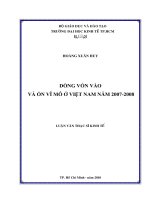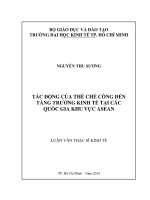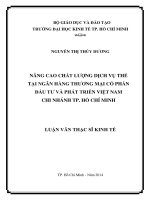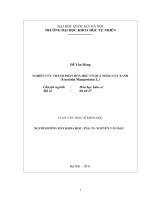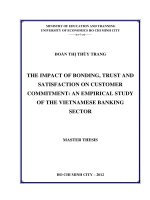The effect of country of origin on brand equity an empirical study of chicken eggs luận văn thạc sĩ
Bạn đang xem bản rút gọn của tài liệu. Xem và tải ngay bản đầy đủ của tài liệu tại đây (637.16 KB, 86 trang )
MINISTRY OF EDUCATION AND TRANNING
UNIVERSITY OF ECONOMICS HO CHI MINH CITY
-------------------------
NGUYỄN VĂN THANH
THE EFFECT OF COUNTRY OF ORIGIN ON BRAND EQUITY:
AN EMPIRICAL STUDY OF CHICKEN EGGS
MASTER THESIS OF BUSINESS ADMINISTRATION
HO CHI MINH CITY - 2012
MINISTRY OF EDUCATION AND TRANNING
UNIVERSITY OF ECONOMICS HO CHI MINH CITY
-------------------------
NGUYỄN VĂN THANH
THE EFFECT OF COUNTRY OF ORIGIN ON BRAND EQUITY:
AN EMPIRICAL STUDY OF CHICKEN EGGS
Subject: Master of Business Administration
Code: 60.34.01.02
MASTER THESIS OF BUSINESS ADMINISTRATION
SUPERVISOR: Assoc. Prof. Dr. NGUYỄN ĐÌNH THỌ
HO CHI MINH CITY - 2012
I
ACKNOWLEDGEMENT
To complete this thesis, a lot of efforts have been put in during the whole MBA
course for three years. Therefore, I would like to give my warmest thanks to:
Respectful lecturers of University of Economics Ho Chi Minh City, who are
enthusiastic in every minute in the class to provide me a huge useful knowledge
which helps me understanding better about economy, especially Dr. Nguyễn Đình
Thọ, who has consulted and instructed me the main contents like research model,
hypotheses and other relevant matters of this thesis.
Friendly classmates of eMBA course 19, University of Economics Ho Chi Minh
City for helping, coordinating with me during the course, especially for always
making class in relaxible and funny atmosphere to absorb new knowledge from the
lectures.
The most special classmate – Mrs. Phạm Võ Thanh Điệp who has married with me
and given many useful discussion and advices during implementing this thesis.
Lastly, the author acknowledges that nothing is perfect so the mistakes and errors
could not be avoided although the author already tried the best. Therefore, the
author is looking forward to any constructive comments and advices from respectful
lectures and friends in order to amend the thesis.
Nguyễn Văn Thanh
Ho Chi Minh, 16th October, 2012
II
COMMITMENT
I would like to commit that this thesis, “The effect of country of origin on brand
equity: an empirical study of chicken eggs”, was completed based on my
independent and serious effort and scientific researches. The data was collected in
reality.
Nguyễn Văn Thanh
III
LIST OF CONTENTS
ACKNOWLEDGEMENT..................................................................................... I
COMMITMENT .................................................................................................. II
LIST OF CONTENTS........................................................................................ III
LIST OF ABRREVIATION .............................................................................. VI
LIST OF TABLE............................................................................................... VII
LIST OF FIGURE ........................................................................................... VIII
ABSTRACT ........................................................................................................... 1
CHAPTER 1: INTRODUCTION ......................................................................... 2
1.1 Introduction ....................................................................................................... 2
1.2 Research background ......................................................................................... 2
1.2.1 General background.................................................................................... 2
1.2.2 Vietnamese background ............................................................................. 3
1.3 Problem statement ............................................................................................. 4
1.4 Research questions ............................................................................................ 4
1.5 Research objective ............................................................................................. 4
1.6 Scope and Methodology of the study ................................................................. 5
1.6.1 Scope of the study ...................................................................................... 5
1.6.2 Methodology of the study ........................................................................... 5
1.7 Structure of the study......................................................................................... 6
CHAPTER 2: LITERATURE REVIEW ............................................................. 8
2.1 Introduction ....................................................................................................... 8
2.2 Country of Origin ............................................................................................. 8
2.2.1 Definitions.................................................................................................. 8
2.2.2. The effect of country of origin on buyer evaluations to products. .............. 9
2.3 Brand, brand equity and its components .......................................................... 11
2.3.1. Brand....................................................................................................... 11
2.3.2. Brand equity and its dimensions .............................................................. 12
2.4 Research model, hypothesis and statements ..................................................... 15
IV
2.4.1. Research model ....................................................................................... 15
2.4.2. Hypotheses .............................................................................................. 17
2.5 Summary ......................................................................................................... 17
CHAPTER 3. METHODOLOGY ...................................................................... 18
3.1 Introduction ..................................................................................................... 18
3.2 Research Design .............................................................................................. 18
3.2.1 Qualitative Research ................................................................................. 18
3.2.2 Pilot test ................................................................................................... 19
3.2.3 Official quantitative Research................................................................... 19
3.3. Sample Design ................................................................................................ 19
3.4 Methods of data analysis .................................................................................. 21
3.4.1 Frequency................................................................................................. 21
3.4.2 Cronbach’s Alpha ..................................................................................... 21
3.4.3 Exploratory Factor Analysis (EFA) .......................................................... 21
3.4.4 Linear Correlation Analysis ...................................................................... 22
3.4.5 Simple Linear Regression (SLR) .............................................................. 22
3.5 Measurements.................................................................................................. 23
3.5.1 Measurements of country of origin (CI)................................................... 24
3.5.2 Measurements of brand distinctiveness (BD) ............................................ 25
3.5.3 Measurements of brand equity (BE) ......................................................... 26
3.6 Research Process ............................................................................................. 27
3.7 Summary ......................................................................................................... 28
CHAPTER 4. DATA ANALYSIS AND FINDINGS ......................................... 29
4.1 Introduction ..................................................................................................... 29
4.2 Descriptions of sample .................................................................................... 29
4.3 Assessment of scales........................................................................................ 31
4.3.1 Reliability testing ..................................................................................... 31
4.3.2 Exploratory Factor Analysis (EFA) .......................................................... 33
4.4 Simple Regression Analysis............................................................................. 35
V
4.4.1 Testing the correlations of constructs........................................................ 36
4.4.2 Evaluating the fitness of the linear regression model with the sample data 37
4.4.3 Testing the fitness of the linear regression model with population ............ 38
4.4.4 Testing the regression coefficient ............................................................. 40
4.5 Summary ......................................................................................................... 43
CHAPTER 5. CONCLUSIONS AND IMPLICATIONS .................................. 45
5.1 Introductions.................................................................................................... 45
5.2 Conclusions of the study .................................................................................. 45
5.3 Implications of study ....................................................................................... 46
5.4. Limitations and recommendations .................................................................. 46
REFERECES ....................................................................................................... 48
APPENDIX 1: CRONBACH’S ALPHA ............................................................ 52
APPENDIX 2: EFA RESULT............................................................................. 58
APPENDIX 3: TESTING THE ASSUMPTION OF REGRESSION ............... 62
Appendix 3.1: Testing the assumption of regression for CI – BE ........................... 62
Appendix 3.2: Testing the assumption of regression for CI – BD .......................... 64
Appendix 3.3: Testing the assumption of regression for BD – BE ......................... 66
APPENDIX 4: REGRESSION ANALYSIS RESULT ...................................... 68
Appendix 4.1: Dependent Variable CI and Independent Variable BE .................... 68
Appendix 4.2: Dependent Variable CI and Independent Variable BD .................... 69
Appendix 4.3: Dependent Variable BD and Independent Variable BE................... 70
APPENDIX 5: PEARSON COEFFICIENT....................................................... 71
APPENDIX 6: QUESTIONNAIRE IN ENGLISH ............................................ 72
APPENDIX 7: QUESTIONNAIRE IN VIETNAMESE.................................... 74
VI
LIST OF ABRREVIATION
BD: Brand distinctiveness
BE: Brand equity
CI: Country of origin
EFA: Exploratory factor analysis
SLR: Simple linear regression
VII
LIST OF TABLE
Table 3.1: Measurements of country of origin ...................................................... 25
Table 3.2: Measurements of brand distinctiveness ................................................. 25
Table 3.3: Measurements of brand equity .............................................................. 26
Table 4.1: Sample descriptions .............................................................................. 30
Table 4.2: Cronbach’s Alpha of reliability testing................................................. 32
Table 4.3: EFA results ........................................................................................... 35
Table 4.4: Person Correlations............................................................................... 37
Table 4.5: Model Summary ................................................................................... 38
Table 4.6a: ANOVA (CI – BE) ............................................................................. 39
Table 4.6b: ANOVA (CI - BD) ............................................................................ 39
Table 4.6c: ANOVA (BD - BE)............................................................................. 39
Table 4.7: Regression coefficients (CI-BE) ........................................................... 40
Table 4.8: Regression coefficients (CI-BD) ........................................................... 41
Table 4.9: Regression coefficients (BD-BE) .......................................................... 41
Table 4.10: Results of testing the hypotheses ........................................................ 42
VIII
LIST OF FIGURE
Figure 2.1 The Aaker’s brand equity model ........................................................... 13
Figure 2.2 Elements of brand awareness ................................................................ 14
Figure 2.3 The main types of brand associations.................................................... 15
Figure 2.4 Research model s .................................................................................. 16
Figure 3.1 Research process .................................................................................. 27
Figure 4.1: The research model with detail of impacts ........................................... 43
1
ABSTRACT
Vietnam has had remarkable result in economic and political for the last twenty
years. Specifically, in term of diplomacy, Vietnam has increased its role on the
international community. In term of economy, Vietnam has integrated deeper and
wider into global economy and become one of the countries with highest gross
domestic products growth. Together with those performances, living standard of
Vietnamese have improved attaching with a higher needs and wants about food for
Vietnamese population. This inspires the need to do a research regarding to food
sector, specially, in the chicken eggs field.
The purpose of this research is to study the impact of the country of origin to the
brand equity directly and indirectly through mediating variable. The data for this
study is collected from consumers who consume chicken eggs and can recognize
the country of origin of the brand name which they bought.
There are 240 respondents, who are in Binh Duong province and Ho Chi Minh city,
selected for analyses in this study. The study used the software SPSS version 11.5
to analyze the data. In detail, the Cronbach’s alpha was used to test the reliability of
measurements, EFA was used to test the validity of the measurements, the Pearson
coefficient was used to test the linear correlation between the variables, and simple
linear regression was used to measure the impact of CI to BE and to BD, and the
impact of BD to BE. The results showed that both CI and BD had positive effect to
BE but the effect of BD was stronger. Therefore, practitioners should pay more
attention the BD when promoting the products. Anyhow, CI had strong effect to BD
so it is important too.
2
Chapter 1: INTRODUCTION
1.1 Introduction
In the first chapter, a general introduction is given as the reasons for doing the
study. The research background including general and Vietnamese context are
mentioned to convince the necessary of this study in practice of Vietnam. The
research problem and the research objective are also provided in this chapter to
strongly support the necessary of carrying this study and how the author determine
the relationship between the variables involved in the research model. In the later
part of this chapter the scope of study and the research method are addressed as well
in order to illustrate a general imagination of what this study is done and what
methods are used to assess the hypotheses. The structure of the whole study is
provided at the end of this chapter to outline a general picture of the study.
1.2 Research background
1.2.1 General background
Food, all the time, is necessary and important to human life. All the countries
around the world are trying to develop their own nation and one of the criteria to
measure the level of development are the amount of food consumption per capita
per year, so all the countries try to maximize their own population food satisfaction.
The fact is that the development is not equal among countries, there are some
countries called rich and developed while others called poor and less developed or
developing countries. The people lives in developed countries getting a better
chance to consume more and better food while the people lives in less developed
countries consume less food and may not be enough food for their basic need. There
is a gap in term of food availability in developed countries and less developed
countries. The reasons of this gap are many but one of them is different level of
technology development. As a result, many companies from developed countries
3
penetrate the less developed countries by exporting their products or investing
factories directly abroad.
When companies export their products or invest factories abroad, they for sure
would like maximize their profit, but the process of getting profit is not easy at all.
The exporting companies and the abroad investing companies are not only facing
the competition among themselves but also facing the competition from local
companies on the same product category. It is important to find out what factors
influence to competition race and help the involved firms increasing their
competition capability. It is significant necessary to do the research and understand
the factors influencing the competition in this case and help both foreign companies
and local companies improving their competitive strength in the real market,
especially in Vietnam market.
Among other food, chicken eggs is one of the most popular food source to
Vietnamese and the author want to focus on this product in this study.
1.2.2 Vietnamese background
In general, the food consumption of Vietnamese is much lower than that of the
world’s average. Vietnamese consume 46 kg of meat per capita per year while that
average amount of the world is 80 kg. Vietnamese consumes 67 eggs per capita per
year while that average amount of the world is 150 eggs (Sơn Nghĩa 2011).
From these information, we can conclude that Vietnam still be a very potential
market for food sector especially the chicken eggs business.
The conclusion above is supported by the practice when many foreign companies
invest into livestock in Vietnam like CP group from Thailand, Jafa Comfeed from
Indonesia, Emivest from Malaysia, and QL from Malaysia ect. and many other local
4
companies like Ba Huan, Adeco, Vietfarm ect., specifically the eggs production.
That why a study in this sector is significant necessary.
1.3 Problem statement
Brands bring a lot of benefits to both customers and firms (Kotler & Keller 2009).
For customers, brands identify the origin of a product so it allows customers to
assign a product’s performance to a manufacturer. Customers might spend less time
to inspect a product before buying if they have experience with the product or a
product under the same brand. For the firms, brands help them protecting some
unique features of their product by registering trademarks, patent or copyrights. A
strong brand also results in a better profit (Kotler & Keller 2009).
There are direct and indirect approaches to measure brand equity (Kotler & Keller
2009). There are many models of brand equity in marketing field and many factors
affecting to the brand equity but to my best knowledge, there is no model applying
for chicken eggs in Vietnam.
1.4 Research questions
The aim of this study is to find out the answers for the following questions:
1. What factors influence to the customers’ evaluation of products?
2. How do these factors influence to the customers’ evaluation of products?
1.5 Research objective
The objective of this study is to examine the impact (direct and indirect) of country
of origin to brand equity, specifically:
1. The impact of country of origin to brand equity
2. The mediating role of brand distinctiveness on the relationship between
country of origin and brand equity.
5
Basing on the study result, author gives some suggestions to practitioners for their
decision making in eggs business sector.
1.6 Scope and Methodology of the study
1.6.1 Scope of the study
The study focuses on how consumers evaluate a chicken eggs brand name basing on
the country of origin and brand distinctiveness. To ensure the collected data
contributes a high level of accuracy, the respondents interviewed are consumers
who consume chicken eggs regularly and who can recognize the country of origin
of the chicken eggs brand name that they buy.
The study is conducted in Ho Chi Minh city and Binh Duong province and done
with two phases. In the first phase, the qualitative approach is employed. The
quantitative is employed in the second phase. More detail about this is presented in
chapter 3 and chapter 4.
1.6.2 Methodology of the study
As mentioned earlier, the study is carried out by two phases: the qualitative research
is used to translate English questionnaire into Vietnamese questionnaire basing on
focus group of 7 people to ensure the translation conveying correct meaning in
Vietnam context. The quantitative research including the pilot test is conducted to
check the suitable of the measurements.
In order to complete the tasks, the software SPSS 11.5 is used to analyze the
reliability, validity and the significance of the research model. In detail, the
Cronbach’s alpha coefficient is used to test the reliability of the measurements.
Exploratory factor analysis (EFA) is used to assess the validity of the
measurements. The linear correlation is used with Pearson coefficient to test the
linear correlation between variables before coming to regression analysis. The
6
Simple Regression analysis is employed to determine the relationship between the
country of origin variable, the mediating variable and the brand equity. Detail of
methodology and the results of these analyses are mentioned in the chapter 3 and
chapter 4.
1.7 Structure of the study
This study is built into five chapters as below:
Chapter 1: Introduction
This chapter introduces a general picture of the study. It also convinces the
necessary to do this research in Vietnam context and highlights the purpose of the
study.
Chapter 2: Literature Review
Chapter 2 presents some previous studies which regard to this research. The model
research and hypotheses are also provided in this chapter. Especially, some
definitions related to the study are mentioned in chapter 2 a well.
Chapter 3: Methodology
This chapter presents the process of doing the study including research design,
sampling and all measurements for testing and measuring the research model.
Chapter 4: Data Analysis and findings
This chapter uses the software SPSS 11.5 to analyze the primary data collected from
consumers. All the analyses results are showed in this chapter together with the
explanation the results. In detail, the Cronbach’s alpha, EFA, linear correlation and
simple regression are employed in this chapter.
7
Chapter 5: Conclusions and implications
Basing on the results in chapter 4, the author withdraws some conclusions,
suggestions for further study and practitioners. The acknowledgement of the
limitations of the study is presented in this chapter as well.
8
Chapter 2: LITERATURE REVIEW
2.1 Introduction
This chapter reviews some theories about brand equity and provides some studies
regarding to the effect country of origin to customers’ product evaluation or/and the
effect of country of origin to brand equity. In addition, some definitions regarding
to all components of this study are also provided. Country of origin does not only
affect the brand equity directly but also indirectly affects brand equity through
mediating factors.
2.2 Country of Origin
2.2.1 Definitions
There are many definitions of country of origin in the literature review. According
to Johansson et al. (1985), country of origin is the country where the headquarters
of the company is located. Bilkey and Nes (1982), defines country of origin of the
products is the country where the products were manufactured or assembled.
According to Samiee (1994), he defines that “Country of manufacture pertains to
firms that maintain a relatively large global network of operations or do business
with a variety of suppliers”. According to Bannister and Saunders (1978), the term
“made in” is used to define the country of origin.
The integration of the world economy and the growth of the multinational
companies make the task of defining the country of origin become more
complicated in the modern marketplace. The term “made in” is blurred as well. For
example, Honda and Toyota are a Japanese manufacturers but some their products
are assembled outside Japan like Vietnam. Therefore, the product assembled in
Vietnam can be denoted “assembled in Vietnam” and what assembled in Japan can
be denoted “made in Japan”.
9
2.2.2. The effect of country of origin on buyer evaluations to products.
Many studies reveal that country of origin affects to product evaluations. According
to Wang and lamb (1983), country of origin effects are not tangible barriers to
penetrate a new market where the new comer facing negative consumers bias
toward imported products. According to a study of Schooler (1965), the products
made in less developed countries are not evaluated as quality products. In his
follow-up study, Schooler (1971) shows that the products of Germany are rated
better than those of Asia, India and Western Europe and Us products are also rated
better than those of India and Western Europe.
A study of Nagashima (1970) shows that Japanese businessmen rate “made in
Germany” as the best while American and British businessmen rate their own
product as the best. In addition, American and Japanese businessmen rate France as
the lowest of the five countries in (USA, Japan, Germany, England, and France). In
his follow-up study, Nagashima (1977) find out that there is a change in attitude
among Japanese businessmen with the “made in” US deteriorated to the lowest
among above five countries while the “made in” Japan, Germany, Britain and
France upgrades significantly.
According to Greer (1971) shows that the older officers rate their home country’s
products higher than the younger officers.
In comparison between more developed countries and les developed countries, there
is a positive relationship between degree of development with product evaluation
according to Schooler (1971), meaning the products from more developed countries
are evaluated higher than those of less developed countries.
A study of Krishnakumar (1974) confirms that the people from developing
countries are unfavourable “made in” image of their home country’s products in
10
term of workmanship, reliability, durability, technical superiority and other
characteristics.
There is a bias within less developed countries on the product evaluation.
According to Schooler (1965), Guatemala students rank products quality from El
Salvandor and Costa Rica lower than domestic and Mexican products quality. This
study also reveals that Guatemala students have negative attitude toward people
come from those countries. According to Krishnakumar (1974), students from India
and Taiwan studying in U.S. evaluate more developed countries products being
better than their own products. Anyhow, Taiwanese students with higher income
evaluate the difference less than do Indian students. Moreover, Taiwanese students
evaluate their own food and fashion better than products from more developed
countries. This reveals that the more developed countries products which are very
different from less developed countries products can not be great substitutes.
According to Erickson et al. (1984), country of origin affects beliefs but not
attitude.
A study of Han and Terpstra (1988) about the effect of the country of origin and
brand name cues to customer product evaluations demonstrates that the country of
origin has more powerful effects than brand name cues on consumer evaluation of
binational products.
Demographic variable also plays an important role in the country of origin effect to
customer product evaluation. The old people rank the foreign products higher than
did younger people according to Schooler (1971) while Wang (1978) do not find
such differences. According to Dornoff (1974), the females rank foreign products
higher than do males. Anyhow, he can not assure this if the products derive from
more developed countries. People with higher education rate foreign products
higher than do people with limited education according to Schooler (1971). Nonwhite people evaluate products from Africa and Latin America higher than do white
11
people according Wang (1978). The white people rate U.S. and North America
products higher than do non-white people according to Schooler (1971). The people
with higher income tend to be more favorable to foreign products in general than do
lower income people according to Wang (1978).
The perceived risk is also considered as a determinant of country of origin effects.
The first research regarding to this topic is conducted by Hampton (1997). In this
study, he investigates perceived risk of American products made in US and abroad
by US firms. The result reveals that the products made abroad is larger perceived
risk in comparison with products made in US.
Personality variables also play a role in production evaluation. According to
Anderson and Cunningham (1972), the dogmatism and the preference for foreign
products have an inverse relationship. Anyhow, the products are made in the
countries with similar culture are preferred more by the high dogmatic persons. The
conservative persons have negative attitude toward foreign products (Anderson and
Cunningham 1972).
2.3 Brand, brand equity and its components
2.3.1. Brand
Brand was “a name, term, sign, symbol, or design, or combination of them,
intended to identify the goods or services of one seller or group of sellers and to
differentiate them from those of competitors” according to definition of the
American Marketing Association (Kotler & Keller 2009). With a certain brand,
buyers could easily trace back the suppliers and may assign performance
responsibility to a particularly manufacturer. Brand also offers a certain quality
level, so help buyers to easily choose products basing on their experience.
12
2.3.2. Brand equity and its dimensions
Kotler and Keller (2009) define “brand equity is added value endowed on products
and services. It may be reflected in the way consumers think, feel, and act with
respect to the brand, as well as in the price, market share, and profitability and the
brand commands for the firm”.
According to Aaker (1991), the value of brand or brand equity contains four
dimensions (brand awareness, brand loyalty, perceived quality, and brand
association) which can build a platform for competitive advantage and future
benefit of the firms. From those, brand loyalty is the core value of the brand equity
because the revenue of the firms depends on the number of the buyers who make a
regular buying. Brand loyalty has a positive and direct effect to brand equity
(Atilgan 2005).
13
The Aaker’s brand equity model is mentioned below to see how brand equity
generates value.
Figure 2.1 The Aaker’s brand equity model
14
According to Keller (1993, 1998), brand awareness refers to the strength of the
brand in customers’ memory. Brand awareness contains two components (the brand
recognition and brand recall). Brand recognition refers to customers’ ability to
confirm the brand in priority. Brand recall refers to customers’ ability to retrieve the
brand.
Brand
recall
Brand
awareness
Brand
recognition
Figure 2.2 Elements of brand awareness
Perceived quality is what customer felt, experienced about the brand. High
perceived quality reflects that customers recognize and differentiate the brand to
other suppliers’ brand. High perceived quality influences customers’ choices and
supports premium price leading to greater earning for the firm (Yoo 2000).
According to Aaker (1991), perceived quality is the central association to brand
equity.
The last dimension of brand equity is the brand association (see figure 2.3). This is
the most abstract dimension and takes different forms but according to Dickson
(1994) and Keller (1993, 1998), it can be classified into three major types
(attributes, benefits, and attitudes). Attributes are the descriptive features what form
a product or service and classify into product-related and non-product-related
(Keller, 1993). Product-related attributes are something relating to physical
composition of a product or service while non-product-related attributes refer to the
external characteristics of the product or service. The second type of brand
15
association is benefits that contain the personal value what customers expect when
buying the products or services and can be separated into three categories
(functional benefits, experiential benefits, and symbol benefits). Functional benefits
are the basic physical and safety need and respond to the product-related attributes.
Experimental benefits refer to what customers feel when using the products and
respond to both product-related attributes and non-product-related attributes. The
symbol benefits are responded to non-related-product attributes and highlight the
need for social approval and personal expression. The last type of brand association
is the brand attitudes which reflect customers’ evaluation of a brand.
Figure 2.3 The main types of brand associations
2.4 Research model, hypothesis and statements
2.4.1. Research model
Based on the study of Yasin et al. (2007) to measure the effects of country of origin
to brand equity, the country of origin does not only affect the brand equity directly



